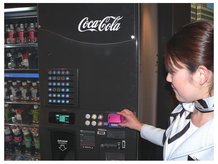Japan report: previewing the phones of the future
How NTT DoCoMo is years ahead of UK networks - and what it means for you
Once better, young Hiroki Tanigawa, gets to travel to the airport for a solo flight, accompanied only by an intelligent wireless device strung round his neck. The ‘Kids’ Concierge’ keeps him on the straight and narrow and even reminds him to do a little airport shopping.
Nightmare Orwellian vision?
Maybe we’re being cynical, but it all sounds Orwellian, rather than Utopian. Nevertheless, NTT DoCoMo's videos do outline a clear vision.
The message revolves around networking – that beaming large amounts of data around some kind of personal or family network, instead of relying on simple voice calls, is where things are headed.
That’s one possible vision of the future – what about the technology companies like DoCoMo will almost certainly bring to the West more imminently?

To demonstrate, next stop was a dummy McDonald’s counter – we got to order a Big Mac and pay for it not using boring old e-cash, but with DoCoMo’s phone-bound credit card called DCMX.
Using the same RFID chip as Osaifu Keitai, DCMX purchases end up on next month’s phone bill, so there’s no need to charge the chip up with cash. Should you prefer to pay now, there’s always the option to do, such as we did at the real Coca Cola vending machine in the same showroom.
Get daily insight, inspiration and deals in your inbox
Sign up for breaking news, reviews, opinion, top tech deals, and more.
As we recently reported, FeliCa, the base technology behind RFID phones and the like is already spreading to the US, so it’s nailed on that similar phone-based payment options will go global.
But it’s DoCoMo’s next project that really intrigues...
Feeding the dog of the future
The final stop on the tour was a mock-up of a living room of the future. Naturally, you enter using a wrist-mounted wireless terminal (what else?) that doubles as an identity checker.
Once inside, everything from feeding the dog to setting the floor-cleaning robot in motion happens through instructions barked at the wrist device. Then things get decidedly Minority Report.
Again an example of the value of finding more ways to use wireless data, the most impressive demo of the day saw us don 3D glasses and step into an immersive representation of ancient Tokyo.
Virtual Edo, as it’s called, allows visitors to walk around and explore the old city, which is painted on the walls and floor by a high-definition projector. Although slightly hard on the eyes, we were clearly able to find our way to an art shop.
Inside, a selection of scrolls on the wall can be examined using a gesture interface that draws them forward in 3D or moves on to the next set of artworks.
As you might have guessed, all this data arrives courtesy of DoCoMo’s theoretical high-speed network, with commands and transaction information flowing back the other way. Yes – we were even able to buy the scrolls and have them downloaded to that wrist dongle. (It has a projector for beaming your art onto a wall or table, by the way.)

E-commerce is (or will be) everything
The point of all this talk of data traffic and e-commerce should illuminate the reason why phone companies are continually planning to build faster and faster networks. After all, it might not seem particularly useful to have high-speed downloads on current phones with their relatively limiting screens.
Back to DoCoMo’s Shuichiro Ichikoshi: “When we were building FOMA, we were like a construction company – installing masts everywhere. Now, however, we can add a software upgrade to it and use that network for the next stage, Super 3G. In fact, we’ll have it ready by 2009 or 2010.”
In other words, the mobile bandwidth to facilitate the scenarios we described above should be here (in Japan, anyway) within a couple of years.
And DoCoMo’s talk of Super 3G is not the measly 7.2Mbit/s of current HSPA connections. Instead, the company is ready to roll out wireless downloads at up to 300Mbit/s, with uploads at 80Mbit/s. Even fibre-optic connections can’t compete with that.
Better still – if you’re hesitating over that ticket to Japan – a 4G network running in Gigabit territory won't be more than a year or two behind it. Just remember to pack your credit card and prepare for some serious retail therapy.
We’ve seen the future.
J Mark Lytle was an International Editor for TechRadar, based out of Tokyo, who now works as a Script Editor, Consultant at NHK, the Japan Broadcasting Corporation. Writer, multi-platform journalist, all-round editorial and PR consultant with many years' experience as a professional writer, their bylines include CNN, Snap Media and IDG.